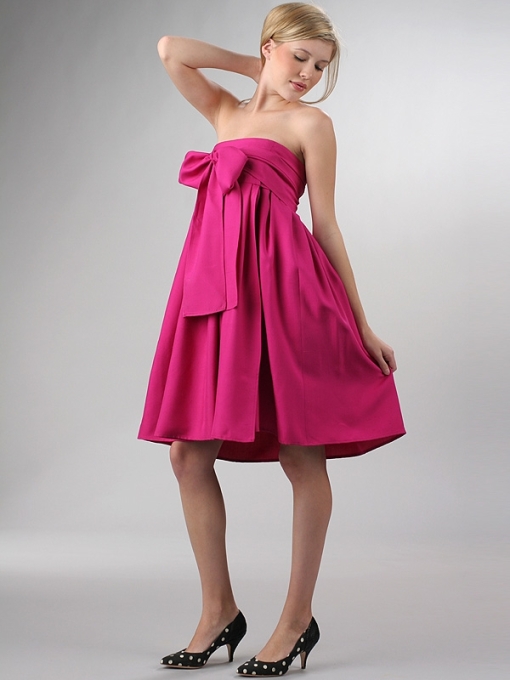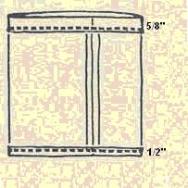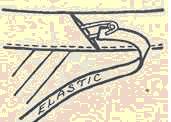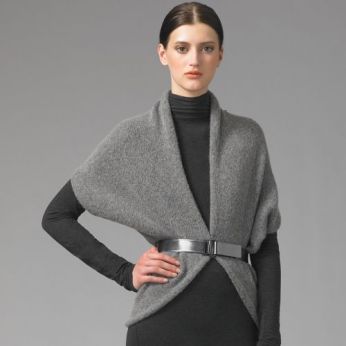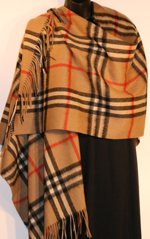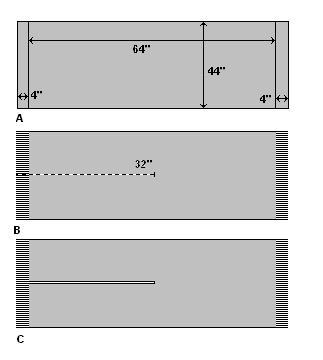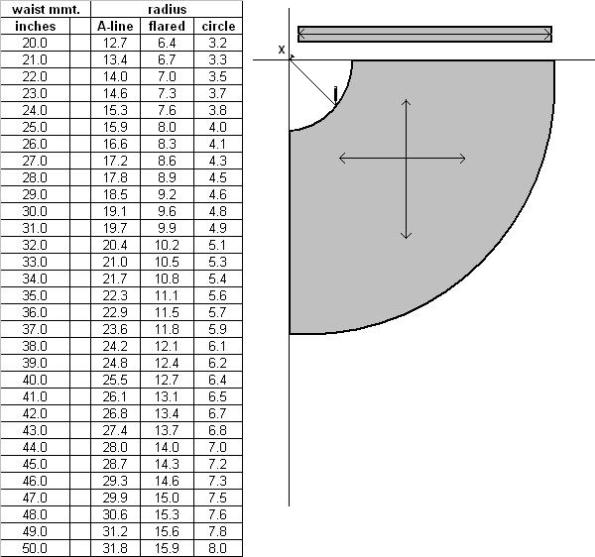
Featured: DKNY Pencil Skirt
Both sexy and classy, the pencil skirt creates a flattering silhouette on every woman, no matter what size. Pair it with an all-business top for work, then slip into a pair of sleek stilettos to glam things up at night. The elastic waistline allows for an adjustable fit and may be worn with a purchased belt. This version of the pencil skirt is fully-lined.
You will need:
- 1 yd. [0.9 m] of fashion fabric, 45″ [115cm] wide
- 1 yd. [0.9 m] of lining, 45″ [115cm] wide
- 1 yd. [0.9 m] of elastic, 1 ½” [40 mm] wide
- Coordinating thread
- Bodkin
PATTERN

This is a simple block pattern. It may be measured and cut directly on the fabric. Seam allowance is included.
CUTTING
Skirt shell (A+5 x B+5) – cut 1X self
Skirt lining (A x B) – cut 1X lining
Waistband elastic – waist measurement less 6″ [15.25 cm]
Note: Cut all fabrics on the straight grain.
ASSEMBLY
 Mark the center of each fabric piece.
Mark the center of each fabric piece.- On the bottom corners of the fashion fabric, measure up 1″ [2.5 cm] and across 1″ [ 2.5 cm]. Join these 2 points with a straight line and cut the corner away.
- Fold this 45° angled line in half with right sides of the fabric together. Pin/baste and sew each corner, using a ½” [1.25 cm] seam allowance, to create a miter in each corner.
- With right sides together (RST), align and match the lining and fashion fabric along the length on both side edges, from the inside corner of the miter to the top edge. NOTE: Remember to allow ½” [1.25 cm] seam allowance on the hem on the lining portion.
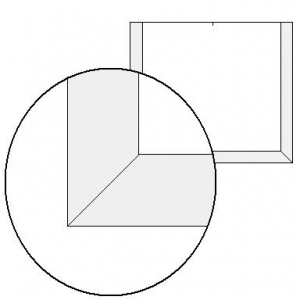 Pin/baste and sew each seam using ½” [1.25 cm] seam allowance. Press the seam allowances towards the lining. Turn this piece right side out.
Pin/baste and sew each seam using ½” [1.25 cm] seam allowance. Press the seam allowances towards the lining. Turn this piece right side out.- Align and match up the centers of each fabric and pin the layers at the top edge. Allow the fashion fabric to turn at the ends and press flat along the fold edges from the top to the mitered corners. Turn the skirt wrong side out.
- Align and match the lining and hem allowance of the fashion fabric along the bottom edge. Pin/baste and sew the bottom edge using ½” [1.25 cm] seam allowance. Press the seam allowance up towards the lining. Turn the skirt right side out.
 Lay out the skirt with the hem away from you and the fashion fabric face up. Fold the fabric along its length so that the 2 sides meet at the center. Measure from the mitered corners 6″ [15.25 cm] and mark the location with a pin. This will be an open slit.
Lay out the skirt with the hem away from you and the fashion fabric face up. Fold the fabric along its length so that the 2 sides meet at the center. Measure from the mitered corners 6″ [15.25 cm] and mark the location with a pin. This will be an open slit.- Working from the open end at the waist, align and match the foldlines from the pin to the top edge. Sew the 2 foldlines together to create the skirt from the inside of the layers.
- Along the top edge, turn under all layers ½” [1.25 cm] to the inside of the skirt and press flat.
- Turn under 1 ¾” [4.5 cm] to create the casing for the elastic waist. Pin/baste the casing through all layers. Press flat.
 Topstitch 1/8″ [0.25 cm] along the fold of the top edge of the skirt.
Topstitch 1/8″ [0.25 cm] along the fold of the top edge of the skirt.- Topstitch 1/8″ [0.25 cm] along the bottom edge of the casing, leaving a 2″ [5 cm] opening at the back seam.
- Cut the waistband elastic to your waist measurement less 6″ [15.25 cm] or wrap around the waist and adjust to a proper fit. Using a bodkin, thread the waistband elastic through the casing and secure the ends together. Be certain not to twist the elastic as you do so. Slipstitch the opening in the casing and complete the topstitching on the skirt.


